#fyi lack of variety =/= none at all
Text
When ppl would complain about the lack of variety in the female characters’ faces/body types in Overwatch
And ppl would be like “ooh but it’s too hard to build an entirely new model from the ground up so it’s easier/more efficient for them to just tweak the existing models they already have”
But meanwhile nearly all the male character models were out here looking like this
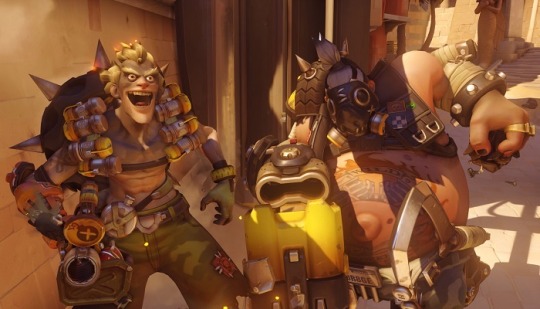

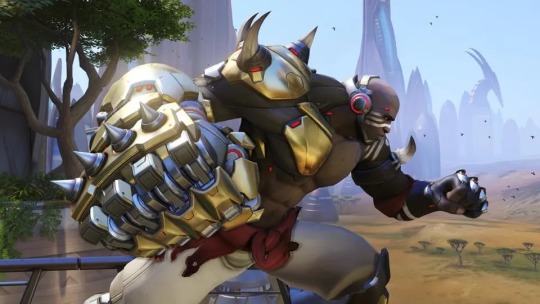
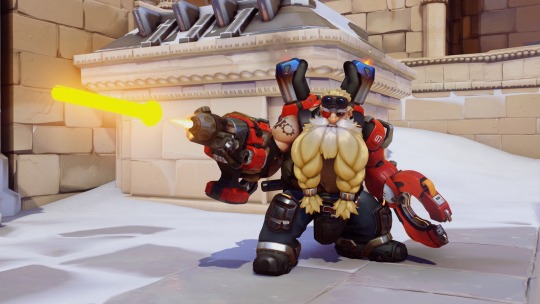
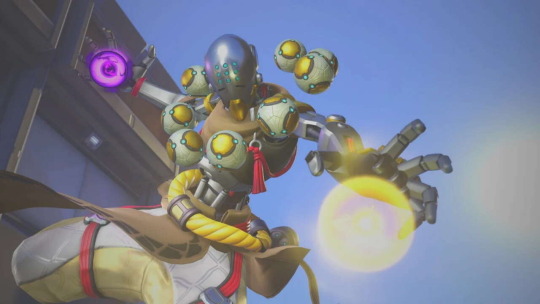

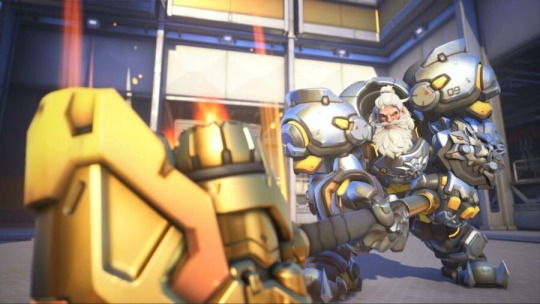

#fyi lack of variety =/= none at all#so don’t start @ing me about the like… idk 3(?) actually unique female character models#I’m aware they exist#chaos chats
10 notes
·
View notes
Text
Written Love
Pairing: Aleksander Morozova/The Darkling x fem!Reader
Summary: As the librarian of the Grand Palace library, you're expected to take care of the books, maps, letters and other documents stored there. You don't expect the General of the Second Army to show up randomly and ask you for a book recommendation.
Warnings: none
Word Count: 2.4k
Authors' Note: Technically this isn't really fem!Reader but there's a part that kind of makes more sense with a fem!Reader which is why it's tagged that way, just fyi. I just want to be safe here and not disappoint anyone. The library is also inspired by the library in my home town which is huge but also very chaotic with shelves standing around everywhere, forming what's basically a big labrinth. It's really cool, honestly. This is also not edited and I'm not a native English speaker.

You smile when your eyes find him, quietly walking through the entrance of the big library, finger gliding along the spines of the many books resting in the shelves as he takes his first steps into the labyrinth of bookcases. He looks at peace here, you think.
On the few occasions where you have seen him outside of your little domain, his muscles had been tense, his jaw clenched and a cold, sharp look on his face, eyes as dark as the fold itself.
But now he looks kind. Kind and sweet and good, even in his dark, scary clothes, his big, heavy boots and bulletproof kefta. He doesn't carry himself as if his whole body is one big weapon anymore. He always takes time to speak with you when he visits, soft spoken and polite as he asks you about your day, the books you read and your work in general.
And other than the other Generals he respects the system after which the books are sorted. He puts everything back where he finds it, brings the materials he borrows back before the due date with no exceptions, and he is quiet, steps always immediately decreasing in volume as soon as he walks through the doors of your library.
Well, it's not your library, technically, but it's close enough. It's not like the king, queen or their children ever made a singular step on the dark wooden floors you sweep twice a day. No, it's just him and the other members of court who visit you.
You don't know why General Kirigan visits though. You've seen the library of the Little Palace on a few different occasions now and it's quite beautiful there. While it's definitely smaller than the library of the Grand Palace you don't think it's lacking in anything.
A part of you is tempted to compare the inventory list of the library in the Little Palace with the borrowing history of the Shadow Summoner, but you can never bring yourself to actually do it. It feels like a violation of his privacy, and what would you even do if you found out that he's borrowing books he could get in his own library here from you? It's not a crime to prefer the Grand Palace library after all, and you do have a much larger variety of books here.
And in the back of your mind there's a quiet voice, whispering that he may be coming here for you, and you fear that the voice will get louder if you choose to compare the lists and find out that he does in fact borrow books from here that he could get in the library of the Little Palace. It's a selfish, foolish thought you shouldn't entertain, but it's also the only explanation that really makes sense. The only clear differences between the Grand Palace library and the Little Palace library is the amount of books and you, and if he's not here for the books-
"Excuse me?" Your gaze finds the eyes of a young servant girl who hesitantly smiles at you. "Could you help me find a book? One of the guests has asked for a copy of Epitome Astronomiae Copernicanae. He says he has unfortunately forgotten his own copy at home and desperately needs it if he's supposed to present his own observations and research at court tomorrow."
Mirroring her smile you nod, opening the folder you use to keep track of all the books, maps and other materials currently outside of the library and placing it on the desk in front of you, before waving your hand to silently ask her to follow you.
Back when you were new here you had a small little map scribbled on a thin piece of paper that you carried everywhere with you, showing where exactly all the categories of books are positioned, but after several years here you know every shelf like the back of your hand. There's not a single book in this gigantic library that you can't locate in thirty seconds maximum, so the little scrap of paper got to retire.
Quickly moving between the many shelves you have to force yourself to slow down a bit to make sure the woman doesn't get lost on the way, waiting a few seconds every time you walk around a new shelf to make sure she can catch up, until the bookcase you're looking for is finally in sight.
You're so deeply focused on finding the book quickly that you don't even notice that someone else is standing two shelves next to this one, your eyes glued to the spines to find the fight title.
"It should be... ah! Here it is." It's a beautiful book, with carefully dyed dark blue leather binding, its title painted on in silver ink. It's so beautiful you could swear that a Fabrikator must've gotten their hands on it at some point in its creation. Slowly pulling it out of its designated place in the shelf you give it to the servant girl.
You're about to walk her back to your desk to fill out the required documents when a voice behind you stops you.
"I'm sorry, could you please help me find a book?"
Whirling around you almost freeze in place when you realise the person who asked for your help is none other than General Kirigan himself, the man himself standing a few metres away from you, spine straight and shoulders stiff in the way you've seen him act outside of the library.
How odd. I thought the library brings him comfort?
"Oh, of course! Uh..." Eyes darting between the General and the Servant for a few seconds, the young woman frees you from your predicament with another kind smile.
"I think I can find my way back to the desk on my own. If I have any trouble filling out the documents myself I will wait for you, alright?"
Nodding quickly you wave as she leaves, before turning back around to the Shadow Summoner, who's now patiently waiting a few steps away from you.
"Alright, General, what can I assist you with? Which book are you looking for?"
His gaze visibly softens, muscles slowly relaxing until he's no longer standing straight like a candle. He finally looks like the version of him you're used to again.
"I'm looking for a novel."
"A novel?" You echo, unable to stop yourself in time. "The novels are in a different corner of the library. What exactly are you looking for?"
He smiles slightly, hand moving to the back of his neck as if he's a bit embarrassed by the answer. "I would like a recommendation from you, actually."
It takes you a few seconds to register what he said. It's quite literally the last thing you expected to hear from the man.
"A recommendation?" you echo quietly, frowning, and watch as he nods.
"You spend all day around these books, and every time I'm here you're reading. I can't imagine anyone else being a better source for book recommendations than you."
To hide the bashful smile sneaking its way onto your lips you turn around, asking him to follow you as you lead him to the other side of the enormous library. This time you don't feel the need to slow down as you walk around the labyrinth of shelves, the General's long legs making sure that he's never far behind you, no matter how quick you are. You already know which book to give him, despite how sure you are that it's not going to agree with his own taste in literature.
When you finally stand in front of the right bookshelf you don't even have to look around to see where the book is, eyes automatically moving to the familiar leather bound object. "I don't think you're the type of person to be interested in this type of stuff, but it is my favorite book, so..." You whisper, more to yourself than to him, carefully pulling the book out of the shelf.
"Oh? Why is that?" the General asks, eyebrows lifting curiously.
You can feel how the apples of your cheeks heat up when you realise that he heard what you said. "Well... uhm. It's just...". It's hard to find the right words, the risk that he's going to take your comment as an insult a bit too big for your comfort. "I don't think you'd enjoy things like silly love stories."
"Silly love stories?" The General sounds scandalised, but there's an amused glimmer in his eyes that calms you down before you get a chance to start panicking.
Humming quietly you nod, holding the book out to the General. "Don't misunderstand me. I think everyone deserves to lose themselves in sweet stories, but you don't seem like the type of person to agree with my mindset. If I had to guess, I would say you're the type of man who thinks all of this soft stuff is just an unwanted distraction from the war."
He purses his lips, eyes focused on the book cover you're still holding out to him, before he carefully reaches out and removes the book from your grasp to open it and read the first page.
"What is it about? I mean, besides the love story. What is the conflict?"
When you take a few seconds to answer him his dark gaze moves to meet yours again, eyebrows slowly lifting as he waits for you to summarise the plot.
"It's, uhm..." Turns out simply recommending someone your favourite book is one thing, while actually having to summarise it to explain why they should read it is an entirely different issue. You're not sure if you can find the right words to explain the plot without sounding like a foolish, overly romantic idiot.
"It's about a servant, Sophie, and a member of the royal court who fall in love." You don't specify that the servant's love interest is technically a General. "So it's mainly about that and the taboo aspect of it, but there's also a whole war going on that is quite important in the majority of the book. It would probably be more accurate to say that it's a political drama with a romance subplot, but I loved the romance so much that it overshadowed everything else in the story for me."
When you finally finish your explanation he has that soft smile on his lips again and a warm feeling starts to become noticeable in your chest.
"Why would I not like a political drama with an outstanding love story subplot?" The shadow summoner asks.
"Well, like I said. I didn't think you would be someone who'd enjoy the love story aspect much, and I think that's what makes this book better than a lot of other political dramas."
The General looks at you for a few seconds, deep in thought, before he closes the book and starts to look through the shelves.
You want to ask him if you can help him find what he's looking for, but he holds his hand up to silence you before you even get the chance to open your mouth, as if he already knows what you were about to say.
"It should be here somewhere..." he murmurs, more to himself than to you, a deep frown on his face.
It takes a bit but after a few seconds the serious look on his face turns back into the smile you love, his hand moving to pull one of the books out of the shelf. When he holds it out for you to take there's a boyish glimmer in his eyes, a spark of excitement that you usually see in children, and you wish you could immortalise it somehow, keep it alive in this sad, tragic world. It feels special to see this type of expression on the usually cold and distant face of the Darkling. Like the Saints gave you a special gift, just for you to keep safe and cherish.
Carefully taking the book out of his hands you let your gaze glide over the ink-black leather cover for a few seconds, fingers tracing the silver drawing of a crescent moon on the front, before you open the book and begin to skim the first page.
"This is my favourite love story." he explains before you even get a chance to question why he has given you this book in particular. "This is the story of Andrei and Isolde. Andrei moves around the country, from town to town, to hide the fact that he is an immortal beast, cloaked in the skin of a human. In one of those towns he pretends to be a Prince from a foreign country and meets Isolde, a clever woman who works as a seamstress. He asks her to make him a cloak for the upcoming winter, and during the weeks she spends working on it, she begins to uncover what Andrei truly is."
Your eyes widen a bit, intrigued by the premise. "What is Andrei?"
He laughs lightly, a sound that reminds you of cold nights during the winter, drinking warm tea and reading a nice book. "You will have to read the story to figure that out."
Closing the book again you move to press it tightly against your chest, wrapping your arms around yourself in the process to stop yourself from nervously playing with your fingers, trying to force the words out before you end up wasting this glorious opportunity. Your mind is racing but this is a chance, an opening, the possible start of something new.
"How about we read each other's book recommendations and then meet up again to talk about it?" you propose, voice a bit too quiet and anxious for your liking. The General is silent for a few seconds, eyebrows furrowing slightly, and you're suddenly very sure that you have misread his softness towards you. That his kindness has just been simple politeness and he has absolutely no interest in spending time with a servant below his own social standing.
"Like a date?" he asks, and before you can get a chance to give into your fear and backtrack, he nods, the smile on his lips widening into a full grin. "I think I would enjoy that, yes. I will try to keep my schedule free for... let's say next week?"
You can't stop yourself from beaming up at him, the happiness you feel rushing through your body like a wave. "That sounds great. I can't wait to start reading. A love story recommended by you can only be fantastic."
"I hope the book brings you as much joy as it has brought me. I'm curious to hear your thoughts on Andrei."
"And I can't wait to hear what you think of Sophie."
899 notes
·
View notes
Note
Which female characters in one punch man are your favorite and why?
The selection is limited, but I've definitely noticed & appreciated the extra effort ONE's put into writing his female characters lately - both in adding more variety with his newer designs (including the wc) and working on fleshing out + humanizing the established ones he already has. All of that is a great plus. (Cause too often in fiction, female chars generally tend to fall flat when they're portrayed as distant or cookie-cutter 'idealized images' of what the -often male- writers perceive them to be, rather than allowing them to actually be relatable flawed people who have the same organic range of aspirations, interpersonal problems, and emotional depth as the males.) Ahem, so I'll admit that early on, none of opm's few women (when we literally only had 2) struck my fancy on what I find appealing/relatable in a character. But that has been steadily changing as ONE's acknowledged where he felt his writing's been lacking and has deliberately chosen to put more work & observation into developing them (ie ever since challenging himself to write Tome as the pov char in REIGEN, I've seen much stronger results even in opm), which I'm very grateful for!
So I'd say the one who's benefited the most from ONE's extra attention so far has been manga Tatsumaki. Whom I can like so much more now compared to her (cold, distant, antagonistic) wc counterpart. Mainly because we've been able to see the full context behind her motivations and what personally drives her feelings, allowing us to sympathize with her dilemma from her perspective. (My favorite panel sequence of injured Tatsu walking away from Fubuki is deliciously bittersweet capturing that sense of familial fondness and sad resignation. Much pain, much angst.) We can feel the extent of how much she takes upon herself (and know why she does so) as both a hero & sister to fiercely protect with a type of love & duty that is both simultaneously noble yet also harmful to herself & others. Like a double-edged sword. Oh how fascinatingly (and tragically) lovely. :') She also gains the Garou parallels in spades (for more flavor) and has been carrying the current arc hard with her specialized abilities. Demonstrating precisely why she's the awesome, active pinnacle of S Class without Blast. Very impressive. Her gremlin form is that extra entertaining cherry on top too. Overall, when it comes to one of opm’s most well-rounded, fully-realized female characters, who’s only gained more enjoyment & appreciation from me over time, I think manga Tatsumaki currently wins this.

...But this could still change! Because I’ve been very proud of wc Fubuki‘s growth already, that I’m still eagerly waiting to witness manga Fubuki gain her equivalent screentime to shine just like Tatsumaki has. (She’s getting very close now, perhaps once she confronts Psykos again.) So at the moment, I still prefer wc Fubuki a little more over her manga counterpart (also the way Murata draws/portrays her as his idealized woman often doesn’t speak/appeal to me when it borders on the unreal. Early Fubuki I also found unrelatable...and fyi even my mother disapproved of her early mindset too.) But it’s in the moments where Fubuki asserts herself vs her sister to grow into a stronger person/hero is what I'm most looking forward to see. Cause we’ve already begun to see shades of that as she improves & steps into her role as a caring -not domineering, and worthy, supportive leader:

That’a girl! :’) But speaking of more good girls, I very much like what we’ve seen from wc Suiko. Who, as one of ONE’s newest creations, probably feels the most ‘real’ to me as a female character in a naturally relatable way. Very good! I enjoy how she’s allowed to be ambitious, disciplined in her craft, prideful & spunky in attitude, yet also feels indignant when others don’t take her worth -compared to her brother- seriously (whoaa how many girls can relate to that), as she introduces a new type of martial arts we hadn’t seen before (drunken fist technique, so she has the potential to claim her fighting niche), and still understandably cries in frustration when she gets in over her head. :’) That, plus the way she still cares for her brother Suiryu, yet challenges & teases him with classic sibling banter is a delight. All this makes for a very refreshing package of a character already, which I can’t wait to see more of (heck, even Murata’s manga couldn’t wait to squeeze in an early cameo of her!)

Runner ups would probably be wc Webigaza and manga Mizuki, who again are great for bringing the extra variety to opm's heroine roster, but I'd love to see more content from them as well. (Which I'm guessing will be more imminent with Webigaza given her relevance tied to the cyborg plot.) Because the more ONE writes them (and of his female chars in general), the better they’ll get~
#opm#tatsumaki#fubuki#suiko#anonymous#replies#so to summarize#tatsu feels the most awesome and fleshed out as a character#while suiko feels the most effortlessly natural to me#and i'm still waiting for manga fubuki to gain her upcoming spotlight to shine but she's VERY close
65 notes
·
View notes
Text
Media Market Research (and why its undermining all the things you love)
Trying to understand what is dysfunctional about Hollywood is an epic task, and the answers are like the stars – arguably infinite. Hollywood is dysfunctional for literally more reasons than I could count.
But market research plays a fairly heavy role in its dysfunction (IMO) and the time has finally come for me to add my professional two cents about this issue. (This rant of mine has been building for a while, FYI. Hence why it is so...comprehensive. There is a tl;dr section towards the bottom, if you want the high level summary)
***
For the last 4+ years I’ve worked in the field of market research, almost exclusively with major media makers like Warner Bros., NBCU, AMC/BBCA, Viacom, FOX (before Disney acquired them), A+E, etc. (this past year I quit the job where I was doing this work for a variety of reasons, many of which will become clear as you keep reading, but I am still listed as a consultant on the company website):
https://www.kresnickaresearch.com/who/ (Rachel)
And just for comparison, here is a Halloween selfie I took 4 years ago and posted on my blog, so you can see I am who I say I am.
I know a fair amount about how market research on major media franchises is conducted and how it influences production, and a lot of these choices can also be at least somewhat tied back to the massive flaws in the market research industry and its impact.
***
First, at the highest level, you need to understand market research in general is not well-conducted much of the time. Even the people doing a reasonably good job at it are VERY limited in doing it well because of financial constraints (clients don’t want to spend more than they have to), time constraints (clients want everything done as fast as humanely possible) and just the inherent problems within the industry that are decades old and difficult to fix.
For example, all market research ‘screens’ participants to make sure they qualify to participate (whether it is a mass survey, a focus group, a one-on-one interview, etc.). So, we screen people based on demographics like race, gender, age, household income, to get representative samples. But people are also screened based on their consumption habits. You don’t want to bring someone into a focus group about reality TV if they don’t watch reality TV. They aren’t going to have anything useful to say.
However, a lot of the people who participate in market research have made a ‘side-gig’ out of it and they know how to finesse the process. Basically, they’ve learned how to lie to get into studies that they aren’t a good match for because most market research is paid, and they want the money. So, a lot of TV and film market research is being done on people who don’t actually (or at least don’t regularly) watch those shows or movies or whatever but have learned how to lie well enough in these screening processes to make it through.
And because of the aforementioned time and money issue, clients don’t want to spend the time or money to actually find GOOD participants. They just accept that as an inevitable part of the market research process and decide not to let it bother them too much.
So, a fair number of the people representing YOU as a media consumer are people who may not be watching Supernatural (for example) at all or who watch a rerun occasionally on TNT but haven’t been watching consistently or with ANY amount of investment whatsoever. You can see why that creates very skewed data.
But that’s just the tip of the skewed iceberg.
***
Second, media market research is conducted in line with the norms of market research more broadly, and this is a huge problem because media is a very atypical product. How people engage with media is far more complex and in depth than how they engage with a pair of jeans, a car, or a coffee maker.
There are only so many things that matter to people when it comes to liking or not liking a coffee maker, for example. Is it easy/intuitive to use? How much space does it take it on my counter? How expensive is it? Does it brew the coffee well? Maybe does it match my décor/kitchen aesthetic? Can I make my preferred brand of coffee in it? The things you as a consumer are going to care about when it comes to a coffee maker are limited, fairly easy to anticipate in advance, and also easy to interpret (usually).
How people mentally and emotionally approach MEDIA? Whole other universe of thing. Infinitely more complex. And yet it is studied (more or less) as if it is also a coffee maker.
This is one of the many reasons I decided to leave the media market research field despite my desire to have some ability to positively influence the process. As so often seems to be the case, I fought the law and the law won. I could never make the other people I worked with in the industry understand that the questions they were asking were not all that useful a lot of the time and they weren’t getting to the heart of the matter. They were just following industry standards because they didn’t know any better and none of them want to admit they don’t REALLY know what they’re doing.
Which leads me to point 3.
***
Most of the people doing this research don’t have any expertise in media or storytelling specifically. They are typically trained as social scientists in the fields of psychology, anthropology, sociology, or math/statistics. And many of them do not have any kind of specialization or education in media/storytelling beyond the English classes they took in high school and the one Media Studies course they took as an elective in college. Most of them have a very unsophisticated understanding of narrative structure, thematics, tropes, subtext, etc. They mainly think in terms of genres at the VERY broadest level.
Also, not infrequently, they don’t watch or have much knowledge of the shows they are supposed to be doing research on, beyond what they’ve read on IMDb or Wikipedia or what is generally common knowledge. Unless they by chance happen to watch the shows themselves (which often they don’t) they often know very little about the shows they are crafting these questions about. Again, partly because they think it is like the coffee maker, and you don’t need to understand it in any depth to research it. (I know this must sound insane to you as avid media consumers, but that is the general attitude among those who do market research)
There is such a lack of sophistication in how people in the business side of the industry understand media and storytelling. Most of them are either MBAs or social scientists and their training has not prepared them to examine fictional works with the kind of depth that people in the Humanities (who are specifically trained to study texts) have. Somehow, despite the fact that the Humanities is all about understanding texts, that is the one discipline they make almost no use of in the business side of Hollywood.
And boy howdy does it show.
***
Point 4 – average consumers CANNOT ARTICULATE WHY THEY LIKE THINGS. Particularly media things.
I know this sounds condescending, but it is my honest observation. It is unbelievably hard to get people to have enough self-awareness to explain why they actually like things, especially things as mentally and emotionally complex as media.
What typically happens when you ask people why they like a TV show or movie, for example? They will tell you what they most NOTICE about the TV show or movie, or what is distinctive to them about it (which may or may not have anything to do with what they actually LIKE about it). They will say things like “I like the genre”, “I think it’s funny”, “The car chases are exciting”, “I want to see the detective solve the puzzle.”
Sometimes you can get them to talk about what they find relatable about it, if you push them a little. But often they leave it at either the level of literal identity (young black woman), basic personality traits (she’s a social butterfly and so am I) or situations they’ve personally experienced (I relate to this story of a man losing his father to cancer because I lost a close family member to cancer).
But the vast, vast, vast majority of them can’t go to the deeper level of:
a) Why X representation of a young black woman feels accurate/authentic/relatable and Y representation doesn’t
b) Why it matters to me that X,Y,Z aspects of my personality, identity, experience get reflected in media whereas I don’t really care about seeing A,B,C aspects of my personality, identity, or experience reflected in media
c) How and why they are relating to characters when they can’t see the literal connection between their identity/experience and the character’s identity/experience. (For example, many people have argued that women often relate to Dean Winchester because a lot of his struggles and past negative experiences are more stereotypical of women – being forced to raise a younger sibling on behalf of an actual parent, being seen and treated as beautiful/sexually desirable but vacuous/unintelligent, his body being treated as an instrument for a more powerful group to quite literally possess, etc. Part of the reason Supernatural has always been such a mystery/problem for the CW and Warner Bros is they could never crack the code at this level. Never.)
Part of the reason they can’t crack these codes is average people CANNOT give you that kind of feedback in a survey or a focus group, or even an in-depth interview (much of the time). They just don’t have the self-awareness or the vocabulary to get it at that level. Let alone asking them to articulate why Game of Thrones is compelling to them in an era where wealth disparity is creating a ruling class that is fundamentally incompetent at maintaining a just/functional society, which is especially concerning at this particular moment, given the existential threat we face due to climate change.
And the truth is, that IS part of what people – even average people – are responding to in Game of Thrones. But what they’ll tell you when you do market research on it is: they like the dragons, they like the violence, they relate to Tyrion Lannister being a smart mouth, maybe they’ll say they like the moral ambiguity of many of the conflicts (if they are more sophisticated than average).
But the ‘Dean Winchester is heavily female coded despite his veneer of ultra-masculinity’ or the ‘Game of Thrones is a prescient metaphor for the current political dynamics and fissures of modern western society’ is the level you ACTUALLY need to get to. And most market research can’t get you that because the people ASKING the questions don’t know what to ask to get to this level, and most of the respondents couldn’t give you the answers even IF you were asking them the right questions (which usually you are not)
And I’m not saying average people are dumb because they can’t do this. But it requires practice, it requires giving the matter a great deal of in-depth thought, and most people just don’t care enough about it to do that while taking a market research survey.
(I know this is going to feel counter-intuitive to people on Tumblr. But you have to remember, you are NOT average media consumers. You are highly atypical media consumers who have far more self-awareness and a much more sophisticated engagement with media than the average person watching TV. If you didn’t, you probably wouldn’t be here talking about it in the first place)
Point 4.1 – People also lie/misrepresent their own experiences to market researchers because they want to maintain certain self-narratives.
You have no idea how many people would get disqualified from our surveys for saying they watched less than 5 hours of TV a week. And sure, that might actually be true for a few of them. But if you watch TV with any regularity at all (which most people in modern America do) you probably watch more than 5 hours a week. The problem is, people think it makes them sound lazy to say they watch 15-20 hours a week, even though that’s about 2-3 hours a day (which actually isn’t THAT high).
People lie and misrepresent their behaviors, thoughts and feelings because it can be socially uncomfortable to admit you do what you actually do or feel how you actually feel, even in the context of an anonymous survey, let alone a focus group or a one-on-one interview. People want to make themselves look good to THEMSELVES and to the researchers asking them questions. But that makes the market research data on media (and lots of other things) very questionable.
For example, one finding we saw more than once in the surveys I was involved in conducting was people would radically downplay how much the romance elements of a story mattered to them, even large portions of female respondents. When we would ask people in surveys what parts of the story they were most invested in, romances ALWAYS came out among the lowest ranked elements. And yet, any passing familiarity with fandom would tell you that finding is just WRONG. It’s wrong.
People are just flat out lying about how much that matters to them because of the negative connotations we have around being invested in romance. And never mind the issue of erotic/sexual content. (I don’t mean sexual identity here, I mean sexy content).
The only people who will occasionally cop to wanting the erotic fan service is young men (and even they are hesitant to do so in market research) and women frequently REFUSE to admit that stuff in market research, or they radically downplay how much it matters to them and in what ways. There is still so much stigma towards women expressing sexuality in that way.
Not to mention, you have to fight tooth and nail to even include question about erotic/sexual content because oftentimes the clients don’t even want to go there at all, partly because it is awkward for everyone involved to sit around crafting market research questions to interrogate what makes people hot and bothered. That’s socially awkward for the researchers doing the research and the businesspeople who have to sit in rooms and listen to presentations about why more women find Spock sexier than Kirk. (Which was a real thing that happened with the original Star Trek, and the network couldn’t figure out why)
Aside from people not have enough deeper level self-awareness to get at what they really like about media content, they also will lie or misrepresent certain things to you because they are trying to maintain certain self-narratives and are socially performing that version of themselves to researchers.
***
Point 5 – Qualitative data is way more useful for understanding people’s relationships to media. However, quantitative data is way more valued and relied upon both due to larger market research industry standards and because quantitative data is just seen as harder/more factual than qualitative data.
A lot of media market research involves gathering both qualitative and quantitative data and reporting jointly on both. (Sometimes you only do one or the other, depending on your objectives, but doing both is considered ‘standard’ and higher quality). However, quantitative data is heavily prioritized in reporting and when there is a conflict between what they see in qualitative versus quantitative data, the quant data is usually relied upon to be the more accurate of the two.
This is understandable to an extent, because quantitative surveys usually involve responses from a couple thousand participants, whereas qualitative data involves typically a few dozen participants at most, depending on whether you did focus groups, individual interviews, or ‘diaries’/ethnography. The larger sample is considered more reliable and more reflective of ‘the audience’ as a whole. However, quantitative surveys usually have the flattest, least nuanced data, and they can only ever reflect what questions and choices people in the survey were given.
In something like focus groups or individual interviews or ethnographies, you still structure what you ask people, but they can go “off script.” They can say things you never anticipated (as a researcher) and can explain themselves and their answers with more depth.
In a survey, participants can only “say” what they survey lets them say based on the questions and question responses that are pre-baked for them. And as I’ve already explained, a lot of times these quantitative surveys are written by people with no expertise in media, fiction, or textual analysis, and so they often are asking very basic, not very useful questions.
In sum, the data that is the most relied upon is the least informative, least nuanced data. It is also the MOST likely to reflect the responses of people who don’t actually qualify for the research but have become good at scamming the system to make extra money. With qualitative research, they are usually a little more careful screening people (poorly qualified participants still make it through, but not as often as with mass surveys, where I suspect a good 35% of participants, at least, probably do not actually qualify for the research and are just working the system).
Most commonly, when market research gets reported to business decision-makers, it highlights the quantitative data, and uses the qualitative data to simply ‘color in’ the quantitative data. Give it a face, so to speak. Qualitative data is usually supplemental to quant data and used more to make the reports ‘fun’ and ‘warm’ because graphs and charts and stats by themselves are boring to look at in a meeting. (I’m not making this up, I can’t tell you how many times I was told to make adjustments on how things were reported on because they didn’t want to bore people in the meeting).
(Sub-point – it is also worth noting that you can’t report on anything that doesn’t fit easily on a power point slide and isn’t easily digestible to any random person who might pick it up and read it. The amount of times I was told to simplify points and dumb things down so it could be made ‘digestible’ for a business audience, I can’t even tell you. It was soul crushing and another reason I stopped doing this job full time. I had to make things VERY dumb for these business audiences, which often meant losing a lot of the point I was actually trying to make)
Point 5.1 – Because of the way that representative sampling works, quantitative data can be very misleading, particularly in understanding audience/fandom sentiments about media.
As I’m sure most of you know, sampling is typically designed to be representative of the population, broadly speaking. So, unless a media company is specifically out to understand LGBTQ consumers or Hispanic/Latinx consumers, it will typically sample using census data as a template and represent populations that way. Roughly 50/50 male/female. Roughly even numbers in different age brackets, roughly representative samplings of the racial make-up of the country, etc. (FYI, they do often include a non-binary option in the gender category these days, but it usually ends up being like 5 people out of 2000, which is not enough of a sample to get statistical significance for them as a distinct group)
There is a good reason to do this, even when a show or movie has a disproportionately female audience, or young audience. Because they need enough sample in all of the “breaks” (gender, race, age, household income, etc.) to be able to make statistically sound statements about each subgroup. If you only have 35 African American people in your sample of 1000, you can’t make any statistically sound statements about that African American cohort. The sample is just too small. So, they force minimums/quotas in a lot of the samples, to ensure they can make statistically sound statements about all the subgroups they care about.
They use ratings data to understand what their audience make up actually is. (Which also has major failings, but I’ll leave that alone for the minute) With market research, they are not usually looking to proportionately represent their audience, or their fandom; they are looking to have data they can break in the ways they want to break it and still have statistically significant subgroups represented.
But that means that when you report on the data as a whole sample – which you often do – it can be very skewed towards groups who don’t make up as large a portion of the show’s actual audience, or even if they do, they don’t tend to be the most invested, loyal, active fans. Men get weighted equally to women, even when women make up 65% of the audience, and 80% of the active fandom.
Granted, they DO break the data by gender, and race, and age, etc. and if there are major differences in how women versus men respond, or younger people versus older people, they want to know that...sometimes. But here’s where things get complex.
So, if you are doing a sample of Supernatural viewers. And you do the standard (US census-based) sampling on a group of 2000 respondents (a pretty normal sample size in market research). ~1000 are going to be female. But with something they call “interlocking quotas” the female sample is going to be representative of the other groupings to a degree. So, the female sample will have roughly equal numbers of all the age brackets (13-17, 18-24, 25-34, etc.). And it will have roughly 10% non-heterosexual respondents, and so on. They do this to ensure that these breaks aren’t too conflated with each other.
(For example, if your female sample is mostly younger and your male sample is mostly older, how do you know whether it is the gender or the age that is creating differences in their responses? You don’t. So, you have to make sure that all the individual breaks (gender, race, age) have a good mix of the other breaks within them, so groups aren’t getting conflated)
But what that means is, Supernatural, whose core fandom is (at a conservative guess) 65% younger, queer, women, gets represented in a lot of statistical market research sampling as maybe 50-100 people, in a 2000-person survey. 50-100 people can barely move the needle on anything in a 2000-person survey. Furthermore, usually in the analysis of data like this, you don’t go beyond looking at 2 breaks simultaneously.
So you may look at young female respondents as a group, or high income male respondents, or older white respondents, but you rarely do more than 2 breaks combined. And the reason for that is, by the time you get down to 3 breaks or more (young, Hispanic, women) you usually don’t have enough sample to make statistically significant claims. (It also just takes longer to do those analyses and as I explained in the beginning, they are always rushing this stuff). To do several breaks at a time you’d have to get MUCH larger samples, and that’s too expensive for them.
And again, I want to stress, this type of sampling isn’t intended to sinisterly erase anyone. Kind of the opposite. It is intended to make sure most groups have enough representation in the data that you can make sound claims about them on the subgroup level.
The problem is that it can create a very skewed sense of their overall audience sentiment when they take the data at ‘face value’ so to speak, and don’t weight segments based on viewership proportion, or fandom engagement, etc.
Point 5.2 – Which leads me to my next point, which is that fandom activity that doesn’t have a dollar amount attached to it doesn’t make you a ‘valuable’ segment in their minds.
One of the breaks they ALWAYS ask for in data like this is high income people, and people who spend a lot of MONEY on their media consumption. And they do prioritize those people’s responses and data quite a bit.
And guess what – young women aren’t usually high-income earners, and although some of them are high spenders on media, high spending on media and media related merch skews toward higher income people just because they HAVE more disposable income.
Older white men are usually the highest income earners (absolutely no surprise) and they are more likely in a lot of cases to report spending a lot on the media they care about.
Having expendable income makes you more important in the eyes of people doing market research than if you’ve spent every day for the last 10 years blogging excessively about Supernatural. They don’t (really) care about how much you care. They care about how much money you can generate for them. And given that young audiences don’t watch TV live anymore, and they give all their (minimal) expendable income to Netflix and Hulu, you with your Supernatural blog and your 101 essays about Destiel is all but meaningless to many of them (from a business standpoint)
Now, some of them kind of understand that online fandom matters to the degree that fandom spreads. Fandom creates fandom. But if the fandom you are helping to create is other young, queer women with minimal income who only watch Supernatural via Netflix, well, that’s of very limited value to them as well.
I don’t want to suggest they don’t care about you at ALL. Nor do I want to suggest that the “they” we are talking about is even a cohesive “they.” Different people in the industry have different approaches to thinking about fandom, consumer engagement and strategy, market research and how it ought to be understood/used, and so on. They aren’t a monolith.
BUT, they are, at the end of the day, a business trying to make money. And they are never going to place the value of your blogging ahead of the concrete income you can generate for them.
(Also, highly related to my point about people lying, men are more likely to SAY they have higher incomes than they do, because it’s an ego thing for them. And women are more likely to downplay how much money they spend on ‘frivolous’ things like fandom because of the social judgement involved. Some of the money gender disparity you see in media market research is real, but some of it is being generated by the gender norms people are falsely enacting in market research– men being breadwinners, women wanting to avoid the stereotype of being frivolous with money)
***
In sum/tl;dr:
Point 1 – Market research in general is not well conducted because of a variety of constraints including time, money, and the historical norms of how the industry operates (e.g., there being a large subsection of almost professionalized respondents who know how to game the system for the financial incentives)
Point 2 – Media is a highly atypical kind of product being studied more or less as if it were equivalent to a coffeemaker or a pair of jeans.
Point 3 – Most of the people studying media consumption in the market research field have no expertise or background in media, film, narrative, storytelling, etc. They are primarily people who were trained as social scientists and statisticians, and they aren’t well equipped to research media properties and people’s deeper emotional attachment and meaning-making processes related to media properties.
Point 4(etc.) – Average consumers typically don’t have enough self-awareness or the vocabulary to explain the deep, underlying reasons they like pieces of media. Furthermore, when participating in market research, people lie and misrepresent their thoughts, behaviors, and emotional responses for a variety of reasons including social awkwardness and preserving certain self-narratives like “I’m above caring about dumb, low-brow things like romance.”
Point 5 (etc.) – Quantitative data is treated as way more meaningful, valuable, and ‘accurate’ than qualitative data, and this is a particular problem with media market research because of how varied and complex people’s reactions to media can be. Also, the nature of statistical sampling, and how it is done, can massively misrepresent audience sentiments toward media and fail to apprehend deeper fandom sentiments and dynamics. There is also a strong bias towards the responses of high income/high spending segments, which tend to be older and male and white.
Side but important point – Research reports are written to be as entertaining and digestible as possible, which sounds nice in theory, but in practice it often means you lose much of the substance you are trying to communicate for the sake of not boring people or making them feel stupid/out of their depth. (Because god forbid you make some high-level corporate suit feel stupid)
***
What can be done about this?
Well, the most primary thing I would recommend is for you to participate in market research, particularly if you are American (there’s a lot of American bias in researching these properties, even when they have large international fanbases). However, some international market research is done and I recommend looking into local resources for participation, where ever you are.
If you are American, there are now several market research apps you can download to your smart phone and participate in paid market research through (typically paid via PayPal). Things like dscout and Surveys On the Go. And I know there are more. You should also look into becoming panelists for focus groups, particularly if you live near a large metropolitan area (another bias in market research). Just Google it and you should be able to figure it out fairly easily. Again, it is PAID, and your perspective will carry a lot more weight when it is communicated via a focus group or a dscout project, versus when it is shouted on Twitter.
However, that’s merely a Band-Aid on the bigger issue, which I consider to be the fact that businesspeople think the Humanities is garbage, even when they make their living off it. There is virtually no respect for the expertise of fictional textual analysis, or how it could help Hollywood make better content. And I don’t know what the fix is for that.
I spent 4 years of my life trying to get these people to understand what the Humanities has to offer them, and I got shouted down and dismissed so many times I stopped banging my head against that wall. I gave up. They don’t listen, mostly because conceding to the value of deep-reading textual analysis as a way to make better content would threaten the whole system of how they do business. And I mean that literally. So many people’s jobs, from the market researchers to the corporate strategists to the marketing departments to the writers/creatives to the C-level executives, would have to radically shift both their thinking and their modes of business operation and the inertia of ‘that’s the way it’s always been done’ is JUST SO POWERFUL. I have no earthly idea how to stop that train, let alone shift it to an entirely different track.
BTW, if you want the deeper level of analysis of why I can’t stop rewatching Moneyball now that it’s been added to Netflix, the above paragraph should give you a good hint
657 notes
·
View notes
Text
The McMansion Hell Yearbook: 1970
(FYI - this is going to be a longer post than usual, so you might want to open it in a new tab if you’re reading it on Tumblr feed. There will be a read more break about halfway through.)
Howdy, folks! Welcome to the first edition of the McMansion Hell Yearbook - a year by year account of how the McMansion came to be. We begin our tour of time in the year 1970.
Why 1970: A Brief History Lesson
Whether or not the McMansion belongs to canonical or vernacular (everyday) architecture is a topic of some dispute - for example, Thomas Hubka, in his book Houses Without Names claims that the McMansion is simply the latest iteration of highly-customized architecture designed by and for rich people, which is why it doesn’t belong in studies of vernacular architecture. However, Hubka himself includes in his evolutionary study of floorplans, a type called “Large Suburban” which features a central foyer flanked by formal rooms leading into a vast living/entertaining space and kitchen. The question of where “Large Suburban” ends and “McMansion” begins is perhaps less of an architectural question than it is a cultural one, but that’s something we’ll discuss in more detail later on in this series.

A Styled Split-Level from a 1960 trade publication. Public Domain.
Meanwhile, Virginia McAlester includes McMansions, called “Millennium Mansions” in the second edition of the Field Guide to American Houses, a phenomenon she places as starting around 1985. However, like most architectural phenomenons, the McMansion didn’t just appear out of nowhere. Its predecessor is what McAlester called the Styled Ranch (and Styled Split Level) - an elaboration of the ranches and split-levels of midcentury featuring the costuming of the simple ranch form in a variety of different architectural styles or themes including Colonial Revival, Neoclassical, Mediterranean, and Tudor. How these styled ranches and split levels escalated into the sprawling McMansions we know today is something this new series hopes to tackle.
Enough history (for now)! Here’s our 1970 house found in none other than Bergen County, New Jersey.

This 5,600 square-foot house features 6 bedrooms and 6 bathrooms and can be all yours for ~$1.8 million USD. You’ll notice a lot of things about this house that are not McMansion-like: its symmetry, its lack of a complex roofline, its unified exterior claddings and window styles. However, this is why the house is interesting - it is not as much a McMansion as it is a proto-McMansion. Many McMansion features are apparent in their nascent form, for example, the competing architectural styles of Tudor (windows) and Neoclassical (portico, front door, quoins), the tacked-on mass containing the three car garage, an ostentatious pediment with elaborate columns, and extruded double bay windows.
The most interesting of these proto-features is the front entryway, an early development of what will be known on this blog as the Lawyer Foyer. We see a large central window above the door (architectural historian Charles Jencks traces this to LA in his book Daydream Houses of Los Angeles, appropriately calling it the “LA Door”), with an outdoor decorative light dangling in front of it, a motif borrowed from certain, usually later iterations of the split level (seen in this example [top left] from a 1963 trade catalog). Let’s step inside:
Proto-Lawyer Foyer (Law School Foyer???)

What’s interesting about this example is that it is very McMansion like in its use of a large curved staircase and over-indulgent chandelier. However, the above-door window has yet to merge with the front door into a transom-window, and the chandelier, though large and ornate, has yet to replace the lantern outside as the lighting feature that can be seen from the street.
Sitting Room
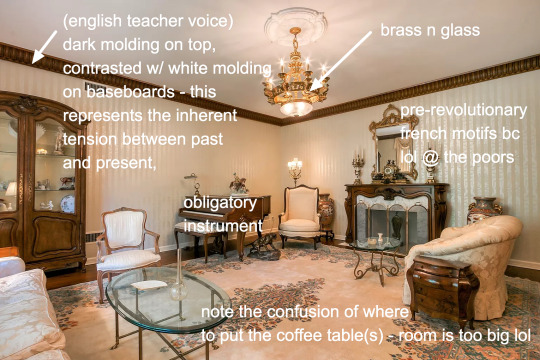
Though this house tends to feature more Louis XV-style furniture (my suspicion is that this might be evidence of an 80s or 90s era redecorating), the emphasis on bulky, ornate 18th century reproduction furniture, moldings, and wallpaper is indicative of the fascination in the 1970s towards the (American) Colonial era in anticipation of the 1976 American Bicentennial. You can read more about this in this fantastic and captivating Collector’s Weekly article.
Dining Room
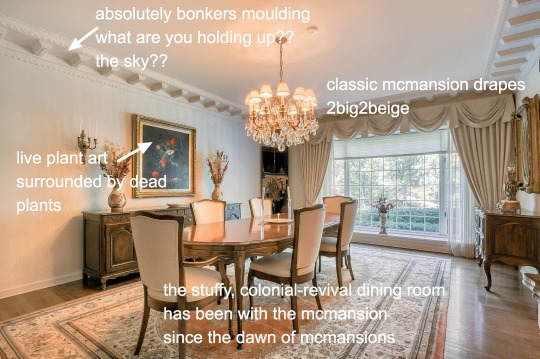
As we can see, the stuffy formal dining room has always existed in McMansions, simply because it has always existed in rich people houses in general since the dawn of time.
Living Room
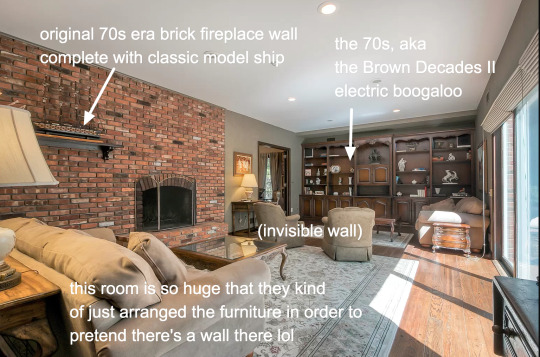
While ugly and too big, this living room definitely is more reminiscent of a ranch-style living room than it is a McMansion great room. It even has doors (heresy!) Personally I stan those 70s brick veneer fireplaces because they are groovy and increasingly hard to find.
Oh. I should mention that you’re really, really not prepared for what you’re about to see in the next room.
Horse Shrine

SERIOUSLY:
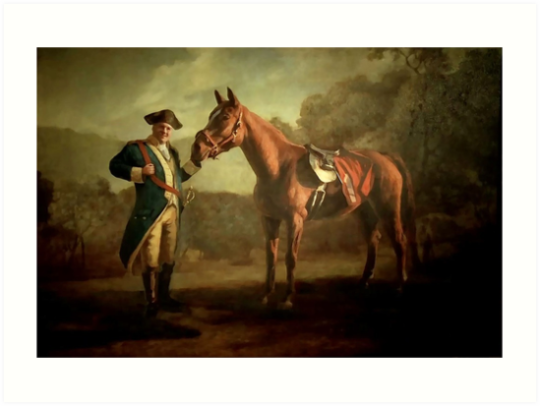
For some reason having a racehorse shrine seems, like, peak New Jersey.
Ahoy, Chef!
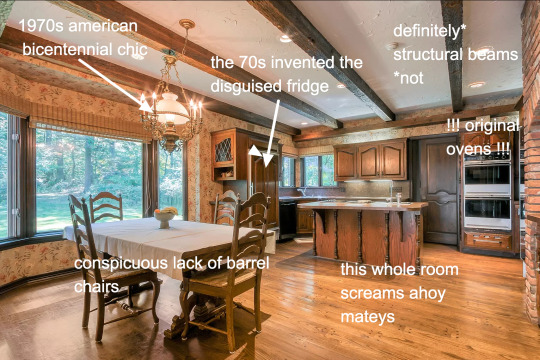
If your nana or great aunt didn’t have these wyd
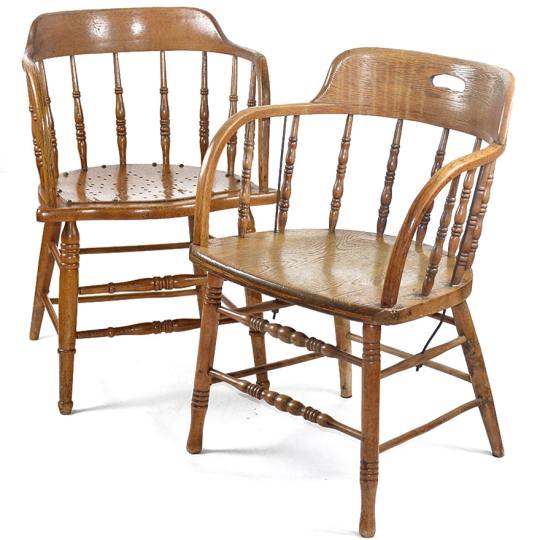
Master Bedroom
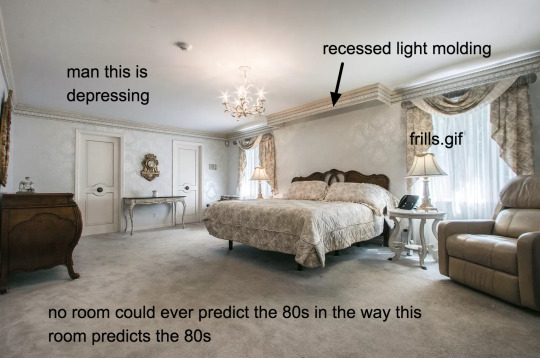
I should add that the listing for this house shows none of the six bathrooms, and, after viewing this room, I have to believe there’s a reason for that.
Spare Bedroom
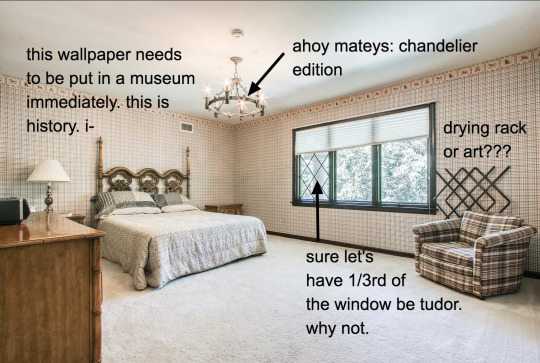
Is there a tacky wallpaper museum?? If so, how do I get on the board of directors???
Anyways, this concludes our interior tour. Let’s go back outside.
Rear Exterior:

Well, on that (thankfully more subdued than usual) note, this concludes our 1970 entry in the McMansion Hell Yearbook. See you soon with an update on Brutalism, and stay tuned for next month’s 1971 McMansion.
If you like this post, and want to see more like it, consider supporting me on Patreon!
There is a whole new slate of Patreon rewards, including: good house of the month, an exclusive Discord server, monthly livestreams, a reading group, free merch at certain tiers and more!
Not into recurring donations or bonus content? Consider the tip jar! Or, Check out the McMansion Hell Store! Proceeds from the store help protect great buildings from the wrecking ball.
#architecture#design#interior design#mcmansions#mcmansion#1970#1970s#70s decor#70s interior#70s architecture#bad architecture#ugly houses#suburbs
2K notes
·
View notes
Note
You mentioned you might do a post on the outfits you hated the most? Not to pole the bear too much but I would love to hear your opinion! I love talking costumes on the show.
Ok I hope you’re ready, because I was largely very unimpressed with a lot of the outfits on the show- several of these are truly terrible, and several are just too repetitive and boring, make of that what you will. Whilst I’m glad we didn’t get typical medieval reenactment attire (and skimpy hose lmao) and I am appreciative of the unique twist they tried to give the clothing on GoT, a lot of it was very lacklustre and boring and should have stayed as curtains or sofa fabric.
A wise man once said, “Fantasy is silver and scarlet, indigo and azure, obsidian veined with gold and lapis lazuli. Reality is plywood and plastic, done up in mud brown and olive drab.” Unfortunately we got a LOT of drab.
Again this is just my personal opinion, if anyone liked any of these outfits, I’m glad you could find some joy from all the misery. Its going to be a long post so I’ve added a ‘read more’ break, but I doubt it will work because Tumblr likes torturing us. Right, off we trot!
1. I have to mention this one first because I fucking hated it so much lmao. Basic, dull, blue on blue, awful heavy cape for the climate, plain boring sick of it haha I won’t linger, I have a lot to get through.

2. I’m going to bunch these all together because these dresses were all awful. When I was in Year 8 we had a Design & Textiles class and I remember sewing something equally misshapen and sack-like. long story short, it ended up in the bin. What the fuck was that neckline, lord it turned my stomach. (This ghastly neckline will make several reappearances, rest assured).


3. Same goes for Catelyn, her dresses were drab and dire (no pun intended) and the neckline made me want to kill myself. She just looked like a frumpy old school teacher, not the wife of the Warden of the North. ( I did like the fur detail on the sleeves of the first dress, however the main body of the dress itself is very dull)
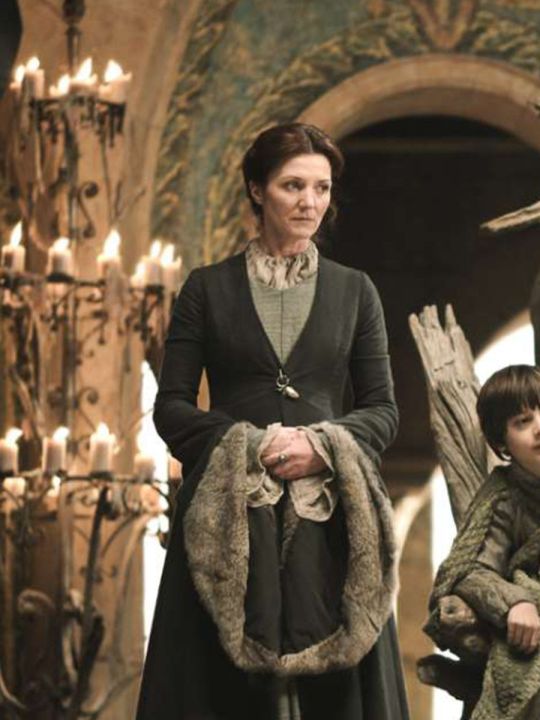

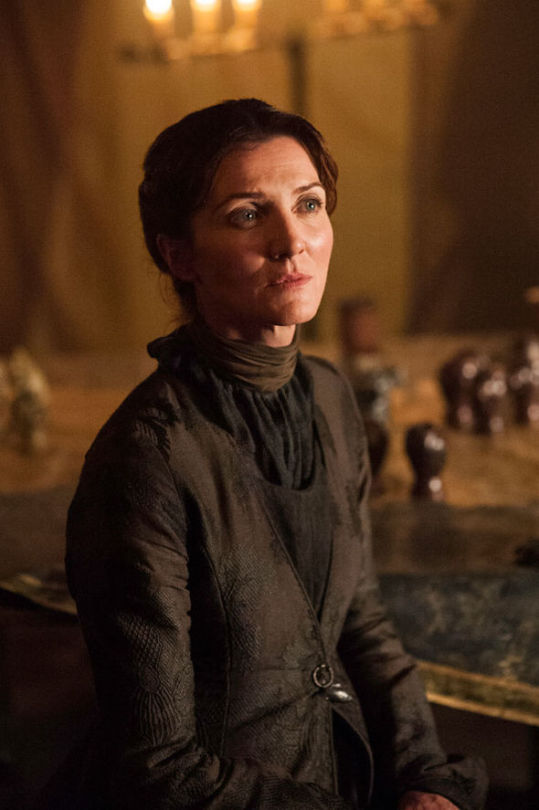
4. Shit dresses seemed to be a trend for the Tully sisters, and my God, Lysa’s were no better. I expected better from the Arryn seamstresses. What is it with the heavy collars and same fucking drapey arms???


5. Really wasn’t a fan of Arya’s “on the run” outfit, it looked moldy and vile and I know she’s meant to be an impoverished urchin but I’d rather it was a plain tunic/jerkin combo that this rotten mess. And that fucking awful neckline again.

6. Ok so Margaery had some overall nice outfits, but what was this fucking catastrophe? Was Olenna Tyrell away from home the day they commissioned this tragedy? She looked like a lampshade- or as @naomimakesart put it a ‘soda-can’.
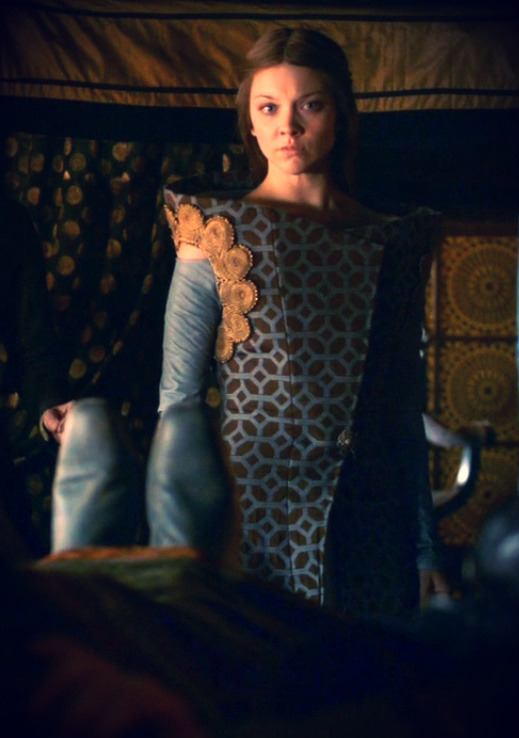
7. This deserved a separate post because after leaving the South to head up North, Sansa clearly couldn’t find a decent dress designer, and I don’t blame her. It’s the North remember? Her wedding dress was a cross between an anaemic peanut and a marshmallow, the neckline, the sleeves- vomitous! And her Winterfell dress was no better. The Boltons probably had shit tailors.

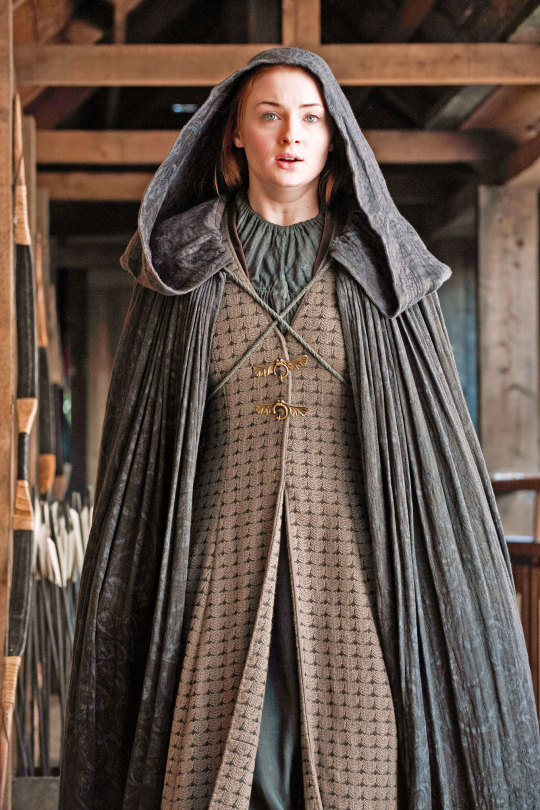
8. Look I know Jon was in the middle of a war but that’s no excuse to wear a ratty old surcoat nicked off a decaying corpse. No excuse. You are the Warden of the North Jonathan!
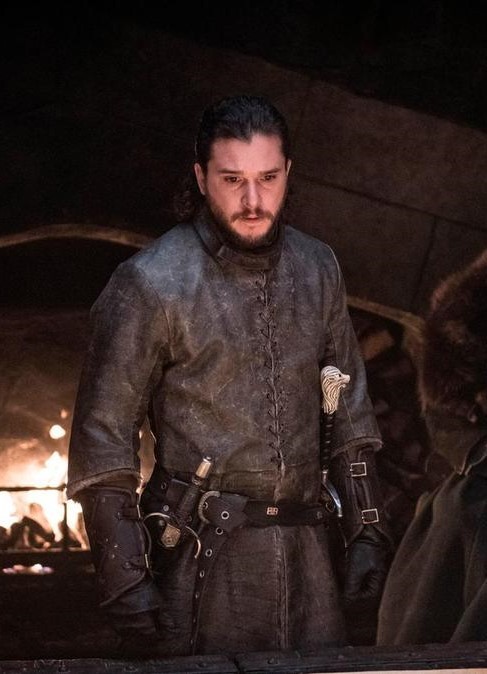
9. Let’s do Dany again. I’ve said time and time again that if anyone deserved to be dressed in silken grandeur with embellishments and veils and jewels and intricate bodices, then it was Daenerys fucking Targaryen, but instead we got this plain, curtain-like shroud. Why is the material so heavy and thick AND UNADORNED???? Boring boring boring, yawn, next.


10. Did they seriously lack for creativity when it came to Dany? Why were all her outfits cut from the same cloth/template? Why did she have massive shoulder pads like an 80s businesswoman? Why did they dress her in the drab habit of a nun???? Why can I upholster my sofa in that same fucking fabric, are DFS in breach of copyright here????? So boring, so homogeneous, so fucking disappointing. Not to mention the pukesome hemline and dreary shade of charcoal- where was the pitch black and vivid scarlet combo I dreamt of???? Oh but it had red detailing- bitch where???? Can’t see a thing without a magnifying glass!


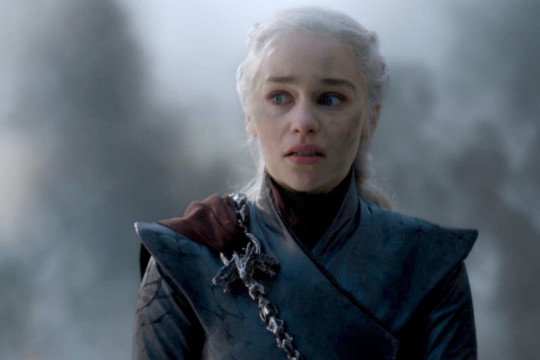

11. I’m not done, you all asked for this haha. It pains me to dredge up this memory, especially when I’ve spent every moment since season 7 aired trying to expunge it from my mind. What. In. The. Name. Of. Fuck. Was. This. Shit? I’m not even going to talk about the casting choices or the wig, I won’t, you can’t make me, but why in Aegon’s name was he wearing an old potato sack and she a Forever 21 2017 summer collection dress the colour of snot? Someone explain this to me right this minute. And what is that wrapped all around it? Did someone make that from papier-mâché??? HEINOUS.
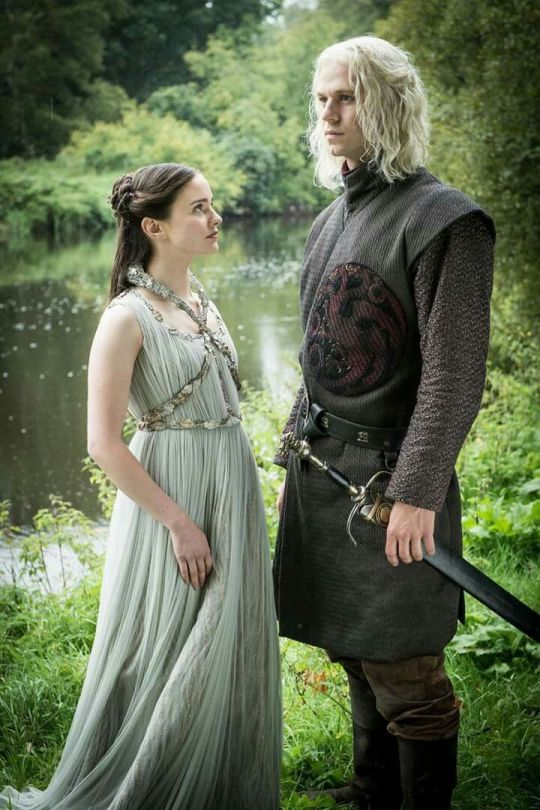
12. The Sand Snakes. Oh the Sand Snakes. Poor girls. Done so so so dirty it makes a wartime latrine look sanitary. What the fuck were they wearing? Where were the elaborate outfits Oberyn’s daughters dressed in (bar Obara ok)???? What is this mess????
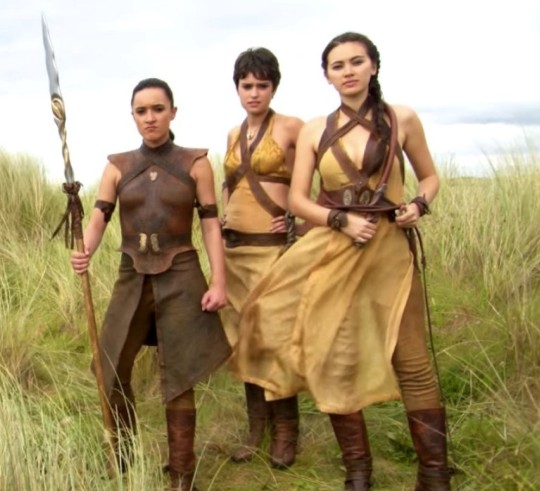
13. Erm so I know Euron was a bit of a joke but I didn’t expect him to dress like a washed-up Alice Cooper fanboy. Then again none of the Greyjoys had decent outfits and travelling all around the world surely didn’t improve Euron’s dress sense either. Next!

14. Now I know people loved Dany’s fur coat, however I was not one of those people. Fine, I was willing to endure it the first time, notwithstanding the fact that she was swamped in it yet again and it’s a good thing Em is adorable and gorgeous otherwise she would have looked like an albino hamster, but why in heaven’s name was the design recycled so often and so unvaried? Furry stripes and shoulder pads folks! Oh adding red to the stripes was a great touch was it? Groundbreaking! It all looks the same, in fact the striped leather coat looked like the fur one after it had been scalded and plucked. Yes I said what I said.
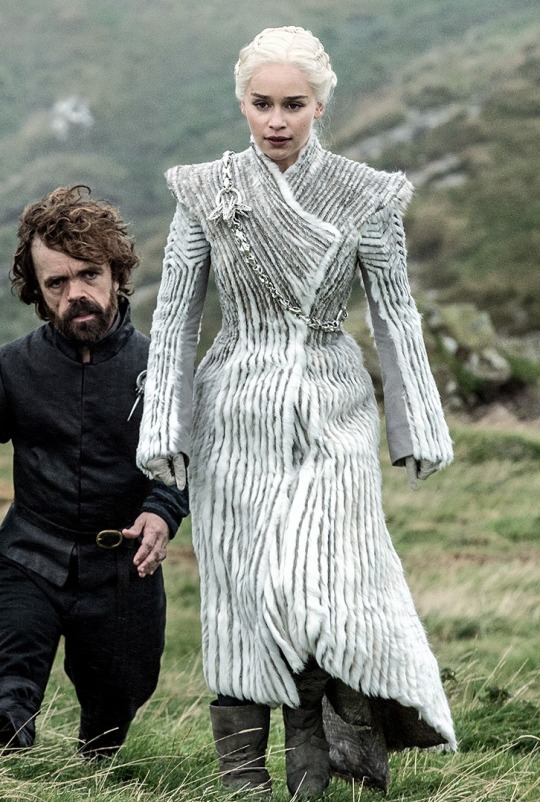



15. I don’t usually rant but lately, I’ve felt the need to get things off my chest. And so I have to add this monstrosity. The hair looks like someone coiled an old hemp rope and pinned it to her head, and the dress, good god the dress is so fucking ugly???? Easily the worst thing Cersei’s ever worn, good thing her gowns improved in the later seasons because holy shit this dress was as grim as the execution itself.

16. Last but not least, this leather coat was ugly and I hated it. So glad we never saw it again after season 1. I’ll add here that the men were all given the same jerkin/surcoat combo with pants and boots and it became very boring after a while. No variance, no style. The only ones with swag were Joff and Oberyn, and dare I say it even Littlefinger’s coats were better than the recycled swill we got with the others.
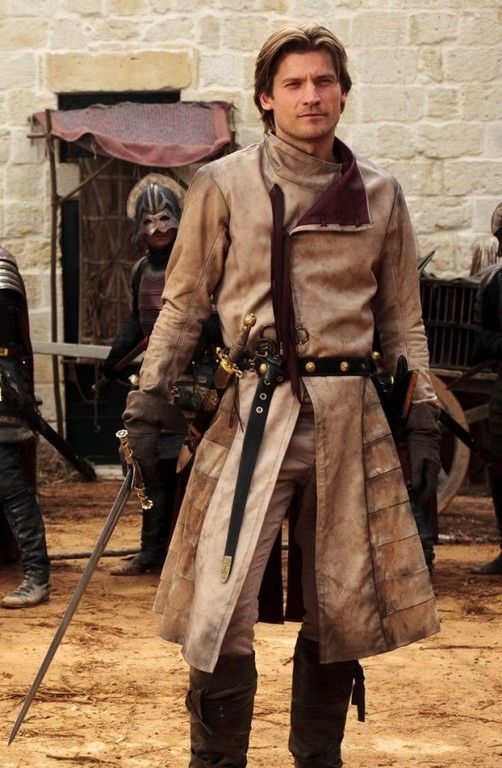
And that concludes this shitshow. I know we’ve been slating D&D’s writing and the shit plot and awful direction the show took but the costumes were always so underwhelming for me. I expected colour and variety and texture from a fantasy/pseudo-medieval setting, not my grandma’s curtains. And the black emo phase was just laughable, but clearly it reflected the deep sense of mourning and tragedy that befitted the end of this memorable show. Sigh. Thank you for bearing with me. I’ve left LOADS of outfits out FYI but you get the gist haha.
97 notes
·
View notes
Text
It’s Not Where Pups are Raised, It’s How
#Poop4U
A recent study in Applied Animal Behaviour Science found that pups raised in the home were more confident and less likely to exhibit fear-related aggression than pups raised in kennels. No surprise there to any of us, given all we know about the importance of social interaction and a varied environment in the healthy development of canine cognition, physiology and behavior. Indeed, a study done in 2013, led by McMillan and co-authored by Serpell and Duffy, found that pet store puppies have more behavioral problems than those raised by private breeds, as did a 2011 study on puppies from commercial breeding facilities. (FYI, see Frank McMillan’s new edition of his book, Mental Health and Well-Being in Animals, a truly excellent and important work.)
Zazie Todd, PhD, who wrote about this latest study in her kick ass blog, Companion Animal Psychology, concluded: “So if you are getting a puppy from a breeder, it’s a good idea to check that the puppy is being raised in the house, and not outside in a garage or barn.”
I know exactly where she is coming from, except . . . I don’t think where is the heart of the issue. I say that, full disclosure, as someone who many years ago raised a few litters of Border Collie puppies first in the house (one to 21 days) and then the barn (22 days until they left for new homes.) Once the pups were moved to the barn, in a converted milk house, they got both hours of social interaction from me, friends and my other dogs, and a profoundly varied environment in which to discover the world.
At least five times a day a pile of puppies tumbled out of the door and went exploring with me, their mom and the other dogs of the farm (Border Collies and Bo Peep, my first Great Pyrenees). They walked through short grass and high grass, dry grass and wet, cold grass. They stumbled over sticks and small logs, some charging forward with abandon, while others fussed and whined behind the obstacle while their litter mates moved ahead. They met butterflies and ant hills and smelled sheep poop and the tracks of foxes and chipmunks and squirrels. The heard bird song, traffic, dogs barking, people laughing, and music. I could go on, but you get the idea.
I thought of this while watching Jane Killion’s wonderful video, Puppy Culture. In it she explains the importance of social interaction, mild levels of stress and a varied sensory environment during the first twelve weeks of a puppy’s life. As I wrote in my review of the DVD (now also available for streaming), you gotta love a women who names one of her bull terrier puppies “Betty Pork and Beans”. As I watched the video, I thought back to watching my puppies struggle through grass over their heads, listening to gun shots from neighbors, and dancing after butterflies. No need for me to have created an elaborate system in my rec room for the puppies to experience mild stress, sensory variety and social interaction.
And so I want to add my voice to the work being done that emphasizes the importance of the environment during early development, and clarify what I think is important–not where, but how.
Speaking of how, I wish there was more research on the effect of litter size on early development. I’m thinking of it now because good friends just helped Kip, a lovely Basenji, whelp a singleton puppy. They were well aware of the concerns about singleton puppies, who miss out on so much of the normal stimulation provided by squirming, squealing litter mates. Years ago my own dog, Pippy Tay, had her own singleton pup, and I was worried sick he’d grow up to have the behavioral problems it seemed I had seen in singletons.
Kip and her litter of one, Hope Solo.
I used puppy-sized stuffed animals to surround and push against him during the day, and gently forced him off the nipple every other feeding time so that he’d encounter mild stress and frustration. (The most common concerns about singleton puppies are frustration intolerance, touch hyper-sensitivity and difficulties with other dogs.) I counter conditioned him to surprise touches with chicken because he began growling around five weeks of age when touched. The growling disappeared after three weeks of conditioning and he went on to be a sweet, lovely and friendly pet puppy for a single woman who loved him liked life itself. She reported that he wasn’t always great at meeting new dogs (even though he’d been around 5 other dogs here), but he was a wonderful, happy dog, and she adored him.
Pippy Tay and a “normal sized” litter of five. The next time she whelped she had a singleton. Sorry for the fuzzy photo, I had to dig deep in boxes of old prints to find this.
But what do we really know about singleton puppies and behavior? Where’s the research? I could find none, althogh there are some good articles about singletons based on personal experience. Here’s a good one from Susan Garrett, with important points about feeding restrictions, frustration and touch tolerance. Although we have no research on the topic (that I know of–anyone?), it seems to me that the number of litter mates could/would have a profound effect on a dog’s eventual behavior. And not just a singleton versus “more”. What about a litter of two puppies? How is that different from 12? Surely 11 littermates creates a substantially different environment and set of stressors than only one or two. Given the lack of research (PhD anyone?), all we have now are anecdotes based on our own experiences. I’d love to hear yours, I’m all ears.
MEANWHILE, back on the farm: The market lambs “went to market today”. (Actually the deed was done here at the farm; which avoids the stress on the lambs of being driven in a truck to somewhere unfamiliar.) It’s an especially bittersweet time because we aren’t planning on any more lambs. We have saved three lovely ewe lambs however, all of which are going to need names. They are all white hair sheep of a similar size, so keeping track of who’s who is going to be tricky. Already we have Spot and Taylor Swift who look a lot alike and can only be distinguished by a black spot on Spot’s knee–not very easy to see most of the time.
Here are the new girls. Pretty adorable, hey? The two on the right are the lambs of Taylor Swift, the one on the left is from Snow White. Any and all ideas for new names are welcome. (I didn’t come up with the names for Meryl Sheep OR Lady Baa Baa. This might be the best feature of social media ever.)
That’s Taylor Swift and one of her lambs on the right. Brown and white Lady Baa Baa is in the middle. She’s become quite the porker. Beyonce is on the left, a daughter of Lady Godiva and without question the ewe I think is the most beautiful.
Maggie is bringing the sheep down from the “moors” to the barn. That’s Lady Godiva in front. She’s doing very well after her medications for pneumonia, but writing this reminded me she needs her second shot today. Just another reason to be grateful for this blog!
Poop4U Blog
via www.Poop4U.com
Trisha, Khareem Sudlow
0 notes
Text
Privacy and the New Health Ciitizen
Data security breaches, access challenges, and privacy leakages plague the current state of Americans’ personal health information (PHI).
HIPAA, the Health Insurance Portability and Accountability Act that was legislated in 1996, isn’t sufficiently robust to deal with the nature of this health information 23 years after that law was first implemented.
That’s not a typo in the title: Ciitizen (spelled with two “i’s”) launched a The Patient Record Scorecard on 14th August. The Scorecard was developed to gauge the progress (and lack thereof) of patient information access afforded by peoples’ health care providers.
What did Ciitizen learn from this process? “The majority of medical record providers are not compliant with the HIPAA Right of Access,” Deven McGraw is quoted on the Ciitizen website. Deven’s observation is made based on Ciitizen’s study into some 3,000 medical record facilities between August 2018 and May 2019.
Deven McGraw is Ciitizen’s Chief Regulatory Officer. [In full transparency, I also consider her a long-time colleague and friend in healthcare. FYI, she was a valuable peer reviewer for the health care privacy chapter in my book, HealthConsuming. Deven was the ideal peer reviewer on patient privacy because she had joined Ciitizen following her tenure as Deputy Director for Health Information Privacy at the Office of Civil Rights, Department of Health and Human Services].
The patient scorecard portal allows us to access and compare information access scores and details by organization, gleaned from Ciitizen’s survey. Health care providers are rated on the basis of a five-star (*) score, where:
* = Non-HIPAA compliant
** = HIPAA compliant requiring substantial intervention
*** = HIPAA compliant with minimal intervention to gain access
**** = HIPAA compliant in a seamless process
***** = HIPAA compliant, patient-focused.
The scorecard website provides details for each of the medical record organizations reviewed. For example, here’s the snapshot of a five-star provider, the Boca Raton Regional Hospital (aka Baptist Health South Florida). [I selected this provider as it was the first provider on the alphabetical list with a five-star review]. Ciitizen’s review of the hospital found no escalations to supervisors were required for patients’ requests for personal information; the requests took 4 days to provide to the patients; and, no follow-up calls were received for the requests.
In contrast, average escalations would be 2, days to send 8, and follow-up calls 3.
Do visit the scorecard website to see providers with scores ranging from the low of one-star lacking HIPAA compliance 100%, through the stars up to five represented by Boca Raton’s leadership for being patient-centered when it comes to providing health consumers quick and efficient access to their information.
Why is this so important? As Deven asserts in her blog on the patient record scorecard, “I came to Ciitizen in 2017 to help enable patients…to use their HIPAA Right of Access to have their health records at the ready, so they can seek second opinions, determine eligibility for clinical trials, and donate their data for research. With the OCR Right of Access guidance front of mind, I was confident we could help our users gather their health information with little (if any) friction. Boy, was I wrong. Sadly, the guidance seems to have made little difference in helping patients easily exercise their HIPAA Right of Access in gathering records from their medical providers.”
A study published in the October 5, 2018, issue of JAMA Network Open found diverse and disappointing results for patient information access among 83 top-ranked U.S. hospitals based on the “top hospitals” list published by U.S. News & World Report in 2016-17.
The study assessed the type of information patients requested (test results, the entire medical record, etc.), request-receipt processing time, and costs to provide the information, among other measures.
The vertical bar chart here is excerpted from the study and illustrates the mean time to release of a requested record to the patient making the request ranged from under 7 days to as much as over a month. When it came to cost, the federal recommendation is $6.50 for a digital record; one hospital in this study charged as much as $541.50 for a 200-page record.
“Requesting medical records remains a complicated and burdensome process for patients despite policy efforts and regulation to make medical records more readily available to patients,” the authors of the JAMA research conclude.
Ciitizen’s business is to enable patients to gain ready access to their health records — something that’s clearly not so easy to do. And the implications of a patient or caregiver not being able to readily access their data can be dire: consider the bar chart and how you would deal with facing waiting over a week for your data so you could get a second opinion for an initial end-stage cancer diagnosis? This was one motivation of Ciitizen’s founder, Anil Sethi, whose sister succumbed to cancer. We are all shoemakers’ children with no shoes at some time in our life, that is something I-know-I-know.
Deven McGraw offers this counsel the patients, which is all of us: “If you’ve requested a copy of your health record and found getting a copy to be difficult, I have some good news for you regarding your rights. You have plenty of them.”
Health Populi’s Hot Points: There’s a huge irony and challenge I discuss in my book, HealthConsuming: From Health Consumer to Health Citizen. In the chapter of “Privacy and Health Data In-Security” (the one that Deven expertly reviewed), I detail the growing volume, variety and velocity of data each of us generates, daily, that mashed up together can paint a complete picture of our health. These are illustrated in the graphic here, which is a riff on the original concept drawn by Juhan Sonin of the Goinvo design studio.
The irony is that, in the U.S., our medical records are held by folks we need to trust to be good stewards of that very personal information. We can’t readily access it, the Ciitizen and JAMA studies, among many others, have shown.
But there are plenty of data “leakages” of the bits of our digital dust we leave through apps and GPS check-ins and social networking posts that third parties scrape together. Many of these fall outside the purview of HIPAA and other U.S. privacy laws covering children online, genetic information, and agreements we sign with third-party mobile app developers.
Clearly, as the Ciitizen team knows and is working on, the HIPAA regulations need to be enforced and fully realized to both protect U.S. health citizens and enable people to gain access to their much-needed health information held by medical record organizations. That’s the “now” scenario.
Going forward, I argue for a more comprehensive form of privacy protection that recognizes the new world of data shown in Juhan’s concept, the kind of which are fellow health citizens in the EU enjoy through the GDPR. It’s an opt-in, not an opt-out, paradigm, with the right to be “forgotten” if we so choose to be.
When we are diagnosed with a condition, many of us want to share our information with researchers, other peer patients, and third parties based on our own values and goals. That’s our call, or should be.
The privacy chapter in my book concludes with a story about a conversation between Judith Faulkner, CEO of Epic (the health IT company) and Vice President Joe Biden. They’re at a meeting of the Cancer Moonshot in August 2017, and Faulkner asked Biden, “Why do you want your medical records? They’re a thousand pages of which you understand 10.”
To which Biden responded: “None of your business.” That story can be found here in POLITICO.
The post Privacy and the New Health Ciitizen appeared first on HealthPopuli.com.
Privacy and the New Health Ciitizen posted first on https://carilloncitydental.blogspot.com
0 notes
Video
youtube
Hello, and welcome to Roly-Poly weight loss. I’m your host, Roly-Poly.
Welcome to day 30!
So, today we are talking about diets. And how they totally don’t actually work. Last time I noted that diet has different meanings, and I’m going to further touch on that.
So, in this Psychology Today article, they make this distinction really much more clearly than I can. “First of all, "diet" is a confusing word because it can mean "the customary food and drink of a culture, a person, or an animal." Usage example: "Mom, my friend is on a vegan diet, so please don't make creamed spinach for dinner." There are also diets prescribed for medical reasons, like the DASH diet or a diet to control diabetes. These are necessary and serve a healthy motivation. But most of us know "diet" in its more insidious incarnation as "a temporary and highly restrictive program of eating in order to lose weight."”
And those, those all caps DIETs don’t work.
As this Medium article asks, have you ever tried a diet and it worked? “I don’t mean “Did you lose weight initially, and then fall off the bandwagon and gain it all back again?” I mean: Did it actually work? Did you lose weight permanently? Was the practice sustainable? Did you feel satisfied and fulfilled? I have a funny feeling that the answer is a resounding no — and for good reason.”
I know that none of mine have worked. Some haven���t even gotten me to the “lose weight” part, let alone all the way to the “gain it back” part. Some of them didn’t even work in the first place, let alone long term!
And it isn’t just my diets that don’t work, or my own self will that isn’t strong enough or whatever. This Washington Post article lays it out in a kind of obvious way.
“Not long ago, the Atkins diet villainized carbohydrates and convinced millions to avoid starches of any kind. Today, the Paleo diet, which purports to emulate the eating habits and digestive systems of ancient humans who lived for many fewer years than people on average do today, is perhaps the most popular — or at least talked about — dietary fad. Soon there will be another fad that sweeps the dieting conversation. And another one. The question that seems to hover over all this diet talk is whether any of the myriad weight loss schemes have worked. If one had, shouldn't it have survived the test of time? And if we've gone this long without a diet that has been shown to work — according to science, not simply the sellers of the fad — will one ever emerge that actually does?”
Netflix actually has an episode of their “Explained” documentary series all about this. They show that American women average 7 diets over their lifetime. Why would we need to try seven different diets if there was one that worked? In fact, their data seems to show that there is no scientific evidence to support any of these diets.
The part that blew my mind, though, was that the first “diet” book was published in 1863! (It was low-carb, FYI.) And this thing became a bestseller. To the point where the author’s name, Banting, is literally the *word* for diet in some cultures! This isn’t just a thing in the last 20 or 40 years. We’ve had over 150 years of this marketing! Surely if there was something that actually worked, we would have figured it out by now.
The Post article interviews Traci Mann, who wrote a book about it after doing 20 years of research at the University of Minnesota's Health and Eating Lab. She explains, “People are too uptight about their weight; people are handling that uptightness in a foolish way that doesn't work (that would be dieting); and the reason diets don't work is not what people think.”
As the Medium article explains, this is because we shouldn’t diet. “Our bodies simply aren’t made to sustain long-term significant weight loss because, more often than not, it’s not in our best interests. Dieting goes against a lot of the intuition that our bodies have developed over centuries of evolution.”
This is what we usually call “starvation mode” - your body freaks out that you’re starving when you’re just trying to diet. And it “sabotages” you to, you know, “save you”.
In her research, Mann notes, “Everyone is blaming dieters for regaining weight they lose, and that's just wrong — it's not their fault they regain weight, and it's not about willpower, or any lack thereof. All this time, doing studies in the lab, almost every single study, without really meaning to, showed some other thing that made dieters overeat. I have found time and again that it's actually some other thing that causes dieters to lose control of what they're eating. But the truth is that everything causes dieters to lose control of what they're eating, because dieting is bound to fail, it is destined to fail.”
Yes, that’s right, it has nothing to do with your willpower! Mann elaborates on this: “What people tend to think is that if only Joe had self-control then he could succeed on his diet forever. And that's not accurate, as it turns out. That's not true. After you diet, so many biological changes happen in your body that it becomes practically impossible to keep the weight off. It's not about someone's self-control or strength of will. [...] There are three biological changes that take place that seem most important to me.”
One is your metabolism, as we know. When you diet and lose weight, your metabolism becomes super efficient, burning less calories, and leaving more to become fat. This is why, often, you don’t just gain the weight back but gain more than you lost!
Medium notes, “The vast majority of people who lose weight through dieting end up regaining all the weight — it’s not just you. As many as 60% of those gain back more weight than they lost. Done repeatedly — as many women who struggle with weight do — dieting can actually cause you to gain weight over time to a level that goes beyond your set point weight, or the weight that best supports your body.”
Mann also says that we have a set point weight, and suggests we aim for this range, instead of some “ideal” thin weight.
Plus, it isn’t just a metabolism thing. There’s also this note from Medium. Your body needs a variety of nutrients, and “Miss out on these nutrients too long — including on many popular diet programs that you may think are safe — and you’ll likely find yourself less than healthy. This can also cause weight gain — it may have nothing to do with calories, but everything to do with the body’s attempt to take care of itself by getting the vitamins and minerals that it needs.”
The second big change that Mann lists is hormonal. “As you lose body fat, the amount of different hormones in your body changes. And the hormones that help you feel full, or the level of those rather, decreases. The hormones that make you feel hungry, meanwhile, increases. So you become more likely to feel hungry, and less likely to feel full given the same amount of food.”
And then we have the neurological changes. “When you are dieting, you actually become more likely to notice food. Basically your brain becomes overly responsive to food, and especially to tasty looking food. But you don't just notice it — it actually begins to look more appetizing and tempting. It has increased reward value. So the thing you're trying to resist becomes harder to resist.”
So her studies show that we’re literally more aware of food, our bodies are literally telling us we need more food to be full, and our bodies are using less of that food for necessities, and turning more into fat. We are literally being sabotaged by our brains and bodies at every turn.
As the Washington Post interviewer sums up, “Calling it unfair doesn't even begin to describe the injustice.”
Finally! Someone who isn’t blaming us for failing!
She has a bit of an insight into willpower, too, which I think is amazing. Like, it is one thing to explain that it isn’t our willpower responsible for our weight gain. But another thing to completely show that we actually have willpower!
“Let's say you're in a meeting, and someone brings in a box of doughnuts. If you're dieting, now you need to resist a doughnut. That is going to take many, many acts of self-control. You don't just resist it when it comes into the room — you resist it when you look up and notice it, and that might happen 19 times, or 90 times. But if you eat it on the 20th time, it doesn't matter how good your willpower was. If you end up eating it, you don't get credit for having resisted it all those times. In virtually any other arena, that would be an A+, but in eating that's an F.”
We should focus on the 19 times, not the 20th, which is not what we tend to do. Mann she goes even further. “If you're studying for an exam, and give in to checking Facebook, those 10 minutes that you waste don't erase the studying you did before. You haven't lost anything. Whereas with eating, when you suffer that one moment of weakness, it actually undoes all the successful willpower that came before it.” This is why you can correlate willpower to something like test scores, but you *can’t* correlate it to weight loss.
Even if you ignore willpower, could diets still maybe work? Yeah, no.
And for people who think their diets are working, Mann has an answer for them too. You’re in the honeymoon stage. “a 200 pound person will lose about 20 pounds in the short run. But the short run isn't the whole story. Everyone acts like the short run is the whole story, and that anything that happens later is the dieter's fault and not really part of the diet. People act like the only part that is the diet's fault is the beginning bit. The long-term part, people always say that's not the diet, that's the person. And yet, it's clear that that's not true. It's over the long term that you see all these biological changes take control.”
Psychology Today adds, “Since dieting, by definition, is a temporary food plan, it won't work in the long run. Moreover, the deprivation of restrictive diets may lead to a diet-overeat or diet-binge cycle.”
Yeah, *by definition* dieting is temporary!!!
And, that leads to different problems! Because diets are just restrictive temporary eating plans. They aren’t actually lessons or lifestyle changes or anything.
“They teach you nothing about healthy eating. Thus, when you've "completed" your fad diet, you simply boomerang back to the unhealthy eating patterns that caused your weight gain in the first place! This is the beginning of "yo-yo dieting," which can bring its own health problems in its wake.”
And, that can lead to more problems. “Dieting, along with the frequent and compulsive weighing that accompanies it, can lead to eating disorders. According to one source, people who diet are 8 times as likely to develop an eating disorder as people who don't.”
Which, if you think about it, makes sense. If you are obsessing over your weight, it isn’t a big jump to a disease where you obsess about your weight.
And none of the articles have a good opinion about the people who create diets or promote them. Mann says, “Well, the first thing is that you can't believe anything that they say. And that's by definition, because their job isn't to tell you the truth — it's to make money. And they're allowed to lie. These companies make their money off failure, not success. They need you to fail, so you'll pay them again. One-time customers are not the sort of thing that keep these diet companies in business.”
Medium is more provocative in their condemnation. “the industry selling you your insecurities has a lot of money invested in it to make sure that you continue to buy diet products. And what’s the only way to keep you buying? By selling you products that are meant to fail.”
And Psychology Today is similarly unimpressed. “Unscrupulous people can peddle "magic weight-loss potions," such as "special" powders and pills, to desperate people, costing them their money and time at best, and fatal health consequences at worse (think "fen-phen," the diet drug that caused often fatal heart valve problems). And have you ever noticed that every diet product claims it will be wondrously effective "if used simultaneously with a healthy diet and regular exercise program?" Skip the magic potions--it's the healthy eating and exercise that are actually the effective ingredients.”
We touched on that in our episode on diet pills, but it can apply to diets in general.
And they do lie - not even about the scientific results, but even about the initial premise. Let’s take the Paleo diet, for example. The whole idea is to cut grains, because that’s how our paleolithic ancestors ate. But as Netflix’s Why Diets Fail Explained shows, the research indicates that our paleolithic ancestors did eat grains. So the whole concept is a lie.
Even worse is the idea of a detox! Our body has a detoxing system, which involves our kidneys and livers and other internal squishy junk, and that, you know, generally does the job. Unless you have medical proof that your body’s own detox system is broken, a “detox” diet is just straight up nonsense.
And this is basically because there are two industries here: the food industry and the diet industry. And they are not the same thing, nor do they want the same things for us. It’s all marketing.
So what do we do?
Well, I’ll get to that. That’s what these next food episodes are going to be about. Because that is it for today!
This has been Roly Poly Weight loss. As always, I am your host, Roly Poly. Please use the hashtag #DietsDon’tWork to share some of the ridiculous diet stories or plans you’ve seen. Some of the old diets and products are ridiculous! So share and we can all have a good laugh!
And please join me next time!
#DietsDon'tWork#Fitblr#Health & Fitness#Fitness#Exercise#Weight Loss#Workout#Weight Loss Journey#Working Out#Health#Losing Weight#Diet#Fat Loss#Nutrition#Cardio#Healthy Lifestyle#Food#Healthy Food#ED#Wellness
0 notes